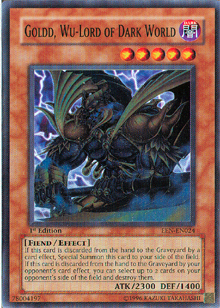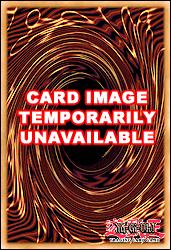Anyone thinking about using the Dark World monsters after seeing their performance at SJC Anaheim will need a strong understanding of costs. When you are just starting out in the Yu-Gi-Oh! TCG it is not uncommon to struggle with identifying costs. They can be quite tricky until you know what to look for. This week we look back the first chapter of my three-part examination of card costs in the Yu-Gi-Oh! TCG. If you want to learn more, just use the archives option to find the other two articles by clicking on “view all articles by this author.”
We’ve stepped into the realm of the Dark World, where ill tidings await any who dare to discard the powerful Nobles. You can beat them into submission, or tribute them, or just drop them into an old deck box you threw into the corner of your room under a pile of old clothes . . . but don’t you dare discard them!
Unless they’re your Nobles, of course. They can be quite forgiving that way.
The Dark World monsters are quite a team. Found only in Elemental Energy, they made their presence known in recent months with the appearance of Goldd, Wu-Lord of Dark World in many Shonen Jump Championship decks. While Goldd is pleased to find so many loyal subjects, his fellow Dark World Nobles are also worthy of adulation.
True mastery over the Dark World monsters requires a firm understanding of how to activate their effects.
The Cost of Nobility
 The term “discard” is highly important to the nobles of Dark World: the guiding force for their entire effect. Beiige, Vanguard of Dark World, Broww, Huntsman of Dark World, Sillva, Warlord of Dark World, and the dreaded Goldd, Wu-Lord of Dark World all share this restriction. Specifically, they must be discarded by a card’s effect. If a Dark World monster is discarded for some other reason—to pay a card’s activation or maintenance cost, for example—it will not be happy with you.
The term “discard” is highly important to the nobles of Dark World: the guiding force for their entire effect. Beiige, Vanguard of Dark World, Broww, Huntsman of Dark World, Sillva, Warlord of Dark World, and the dreaded Goldd, Wu-Lord of Dark World all share this restriction. Specifically, they must be discarded by a card’s effect. If a Dark World monster is discarded for some other reason—to pay a card’s activation or maintenance cost, for example—it will not be happy with you.
In order to get a better sense of this, let’s review what we know about costs in the Yu-Gi-Oh! TCG.
- Activation costs are paid to activate an effect of a card. They are paid before the activation of a card, not after.
- Maintenance costs are paid to keep a card on the field.
- Non-maintenance costs normally appear on monsters or continuous spell and trap cards. Non-maintenance costs also include those in which an opponent is forced to pay a cost, instead of the player who controls the card.
Paying a cost involves giving up something in your possession so your card will carry out an effect. You may have to give up life points, discard from your hand, tribute monsters, or remove cards in your graveyard from play to pay the cost. The act of paying will always involve losing something and will never involve a gain. For example, you do not pay for a cost by gaining life points or drawing cards.
With this in mind, let’s examine the process of activation costs. If a card has an activation cost, it is normally paid before the card resolves (and whatever action it will perform takes place), but the way it is worded is not constant. In the early days of the Yu-Gi-Oh! TCG, it could sometimes be quite difficult to tell if something was an activation cost, or simply part of the card’s effect. After a few sets, however, things began to improve. Today, it’s much easier to spot activation costs.
Examine the text of Lightning Vortex for a moment. The very first line says, “Discard 1 card from your hand.” This brief line represents the cost you need to pay in order to activate Lightning Vortex. Everything that follows will occur when it is resolved. Activation costs are paid before the card is activated—which means the card hasn’t even done anything yet—and this line of text reflects this reality.
If you look over your collection of cards, you’ll definitely recognize this form of text. Cards like Magic Jammer, Monster Reincarnation, Card of Sanctity, Brain Control, and System Down all share this text form, and for each card, the first line of text is indeed their activation cost. That doesn’t mean that the first line of every card is its cost, however. Take Rock Bombardment, for example. The first line of its text tells you to select a Rock-type monster from your deck and send it to your graveyard. This may seem like a cost, but is it not. The act of searching your deck to find the card you will send to the graveyard does not allow it to be a cost. How about Conscription? Its first line says, “Pick up the top card of your opponent’s Deck.” Does this sound like a cost? No. You aren’t giving up anything, so it can’t really be a cost.
Activation costs can also take another form. The first line of text for the card Shifting Shadows says, “Pay 300 Life Points to rearrange the face-down Defense Position monsters on your side of the field.” This may seem like one continuous action without any pause in between, but that’s not the case. The portion of the text that says, “Pay 300 Life Points” is the effect’s activation cost. What follows it is an explanation of what you get in return when you resolve the card’s effect.
The link between the two actions is the word “to.” “Pay 300 Life Points to rearrange the face-down defense position monsters on your side of the field.” It separates the stated cost from the card’s effect, and can be found in numerous other cards, usually in some variation of the following combination:
[paid activation cost] to [effect you will resolve].
 Winged Kuriboh LV10, Release Restraint, Spell Shield Type-8, and , all use this phrasing to express the cost of activating their respective effects.
Winged Kuriboh LV10, Release Restraint, Spell Shield Type-8, and , all use this phrasing to express the cost of activating their respective effects.
However, this type of text doesn’t always refer to a cost. Some cards like Reload follow it with another line of text that states an immediate follow-up action using words like “then” or “after”. In Reload’s case, it says you “then” draw cards equal to the number of cards you shuffled back into your deck.
Some cards are very specific about when you’re paying an activation cost. The first line of Armed Changer from Elemental Energy says, “Send 1 Equip Spell Card from your hand to the Graveyard to activate this card.” This phrasing is just about the most straightforward case of an activation cost you will see. More examples can be found on cards like Dark Deal, Level Up!, Elemental Burst, and Twin Swords of Flashing Light - Tryce. The activation cost for these cards is fairly self explanatory.
Preventative Maintenance
Maintenance costs demand payment in order to keep your card on the field. Failure to pay this cost results in the loss of your card. These costs are not actually generated by the card’s effect, and thus will not be negated unless a player uses a card that specifically allows it to do so. For example, Pandemonium allows you to negate the maintenance costs of the Archfiend monsters from Dark Crisis, while Skill Drain will have no impact at all.
Imperial Order is the first major card with a maintenance cost to see play in many decks. During your standby phase, it demands a life point payment in order to remain active in the game. If you refuse to pay, or if you simply can’t afford it, Imperial Order is destroyed. Over time, players began trying to use Jinzo to negate the effect of Imperial Order and hopefully allow them to keep it on the field without paying for it. Unfortunately for them, it didn’t work out that way. Maintenance costs mean that simply negating a card’s effect won’t cut it. You need to use a card with a specific ability to affect the maintenance cost.
Non-maintenance costs, on the other hand, aren’t paid to activate an effect or keep a card on the field. Instead, they are added to actions that normally wouldn’t involve a cost, like declaring an attack. Since these costs are actually part of the card’s effect, they can be negated.
Several monster cards have non-maintenance costs that are paid in order to allow the monster to attack. Dark Elf and the Toon monsters from Magic Ruler won’t be able to attack until you pay a required amount of life points. Insect Queen takes things even further by demanding a tribute to feed its hunger, or it will not attack. The continuous spell card Toll makes the same demand, but places it upon every monster in the game.
With cards like these, it’s possible to defeat cards with non-maintenance costs by simply negating the card’s effect. For monsters, Skill Drain will quickly do the job, while Spell Canceller will handle the spells and Jinzo or Royal Decree will handle the traps.
Next week, we will take what we have learned about card costs and apply it to the Dark World monsters. Don’t miss it!
Until next time, send all comments to Curtis@Metagame.com.